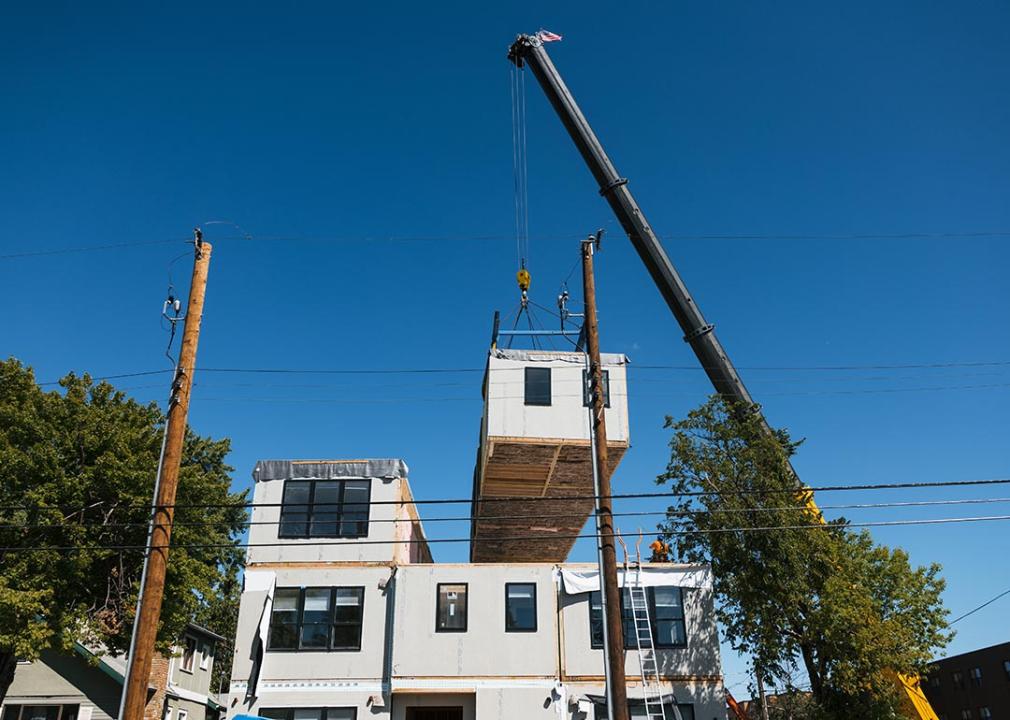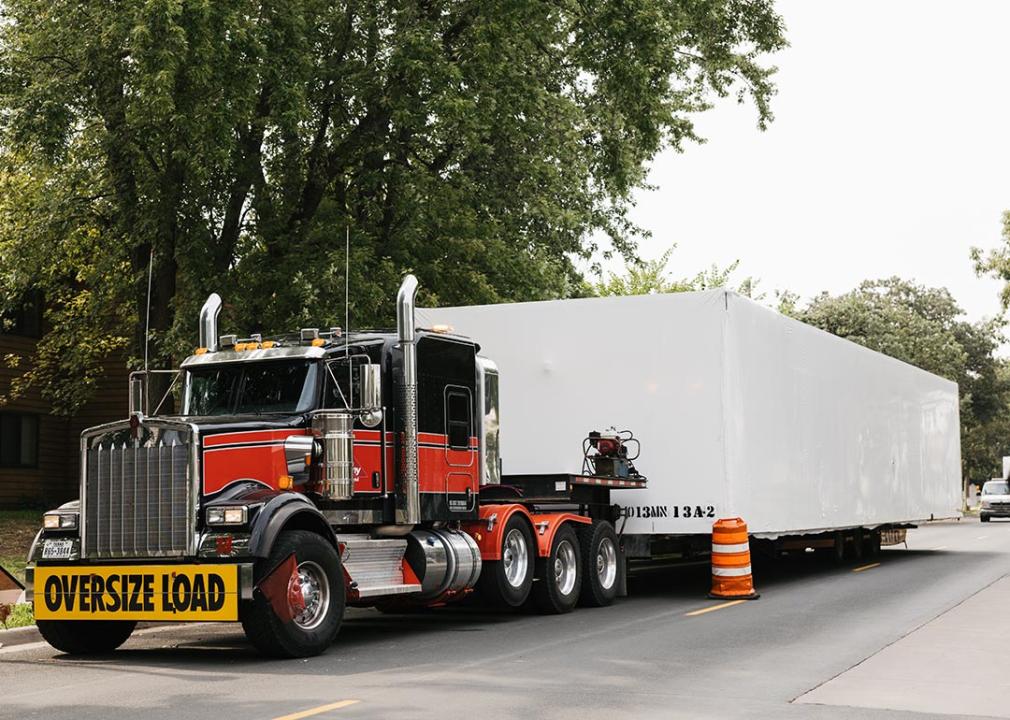


When Minneapolis' housing authority put out a request to build affordable housing at scale across the city, eight teams of designers, developers and architects submitted proposals. The winning bid: a plan for modular housing.
What set modular construction apart from the pack? It delivered on speed, Minneapolis Public Housing Authority officials say, saving it time and money and helping it shorten the city's nearly 7,500 person waitlist for affordable units.
Next City reports that within 14 months, the Family Housing Expansion Plan, which serves an estimated 420 people, went from groundbreaking to completion on two- and three-story buildings on 16 sites across 13 Minneapolis neighborhoods. Last year, 84 units of deeply affordable housing — for households making 30% or less of the area median income — opened to the public.
Is modular construction the way forward for America's overburdened and under-resourced housing agencies? Because of the time and cost savings, modular construction should be an important tool in efforts to make affordable housing truly affordable, says Peter Anderson, architect and professor at California College of the Arts.
"There are possibilities for modular construction to revolutionize the way affordable housing can happen," he says. "But it's going to take changes all through the system, from the design end, project delivery end, the optimization in factories."
Across the country, the shortage of affordable homes grew to 7.3 million last year, according to the National Low Income Housing Coalition. Over half of all renters pay more than 30% of their incomes to rent, according to Harvard's 2024 report on the state of U.S. housing.
Meanwhile, costs to build housing have increased nearly 29% since 2020, according to the National Association of Home Builders, an industry trade group. The expense to develop affordable housing has risen alongside this general increase. Affordable housing development can cost from $100,000 to $750,000 per unit, one 2018 governmental report found. In tight housing markets like California, the per-unit development cost with traditional financing methods has grown to over $700,000.
"I think an optimized system of modular construction for affordable housing should be able to make two to three times the amount of units for a given amount of money," Anderson says.
Modular construction is largely completed off-site in a climate-controlled factory assembly and then delivered to the build site and attached to permanent foundations.
Most modular is split into two categories: flat pack and volumetric. Flat pack refers to when components are shipped from the factory and put together on the job site, like a complex Ikea furniture build. Volumetric refers to nearly finished boxes, with plumbing, electrical, cabinetry and other fixings already constructed.
The units are then transported in full. That requires less work at the build location than traditional construction, but can be more complicated and costly to ship.
Labor, construction costs, land and materials, zoning limitations and the complexity of financing through various public subsidies produce the high costs of building affordable housing, according to a report from Center for American Progress. Moreover, the subsidies required to build affordable housing are a bottleneck, elongating the production timeline, says Kevin DeGood, the center's director of infrastructure policy.
The reduction in labor, time and procurement expenses that modular promises allow it to accelerate development schedules by 30% to 50%, be two-thirds more energy efficient than traditional construction and save up to 20% in costs versus on-site construction of low-rise multifamily projects, their research found.
Modular construction is continuing to gain traction due to these financial advantages over traditional on-site construction, says Bay Area architect and modular housing designer Charles Bloszies.
"When you build in the factory at the same time you are building at the site, you cut down overall project time significantly," he says.
While the Minneapolis Public Housing Authority can only build affordable housing, its partner for the modular housing project, RISE Modular, has built below market rate apartments. Officials say the modular construction model means these are naturally affordable, without subsidies; the lower costs allowed RISE to pass those savings onto tenants.
But DeGood cautions that technological improvements alone are not enough to change the state of the American housing supply. "Certain parts of the country are just hostile to new housing construction."

Despite use of prefabricated houses dating back to western migration in the 1800s and to "catalog houses" sold by Sears, Roebuck and Co. in the early 20th century, modular construction has yet to become dominant in the U.S. housing industry.
But the modular market is growing. Modular construction was among initiatives the Biden Administration in 2022 named as ways to raise the nation's housing supply. Across U.S. residential and commercial sectors, modular construction was estimated to represent more than 6.6% of new construction started in 2023, representing more than $14 billion in total project value, up from $3.7 million in 2015, according to trade association Modular Building Institute. Multifamily and workforce residential housing represented 20% and 8% respectively of the total projects.
Globally, the modular construction market size is expected to grow from around $84 billion in 2023 to more than $130 billion by 2030, per a recent report from market research company Fortune Business Insights.
In its Budget 2024, the Canadian government earmarked $500 million for developers with innovative construction techniques, like modular housing, as part of a larger strategy to leverage federal housing financing to encourage local governments to align building codes, says Leonard Catling, a spokesperson for the Canada Mortgage and Housing Corporation.
Canada established a goal to build a minimum of 2 million new homes by 2031, on top of the 1.87 million it forecasts will be developed in that period. Canada's housing corporation insured its first project through a new pilot loan insurance program for modular construction in fall 2023, generating interest in modular and other alternative construction industries, according to Catling.
"To tackle the housing crisis and create vital housing supply we need to invest in ideas and technologies like modular homes, mass timber production, "panelization," 3D printing and pre-approved home design catalogs," says Catling.
Yet the promise of reducing labor and the growing investment of venture capital into modular (and into the less proven 3-D printed) housing market looking to turn a profit should raise alarms, housing policy analyst Katelin Penner argues.
Though high-quality modular construction is preferable to designs that use shipping containers — like Marston Court in London — there are more common-sense solutions to lower the cost of housing, Penner says.
Cutting out developer fees and lowering interest rates, and using a public developer to cut out the profit motive — such as the Social Housing Development Authority recently proposed in the New York State Legislature — reduces the price to build and protects union jobs, Penner explains. Eliminating developer fees alone could reduce costs by 10%, per a report Penner co-authored on social housing.
Modular has also increasingly become a tool for constructing housing for people without homes. In San Mateo County near San Francisco, Bloszies has designed several "campuses" dedicated to serving people experiencing homelessness. Yet he says he's found that governments are often excited about building cheaply but willing to neglect the population's needs.
"There's no sense of community, the support buildings are an afterthought, and you end up with a camp that you just cleaned out, in more sturdy boxes, but it really hasn't solved or addressed the root problems."
In his plans, Bloszies uses input from service providers and residents, creating outdoor spaces, offices for support staff, quiet areas and — in one campus — a dog run. He's also open-sourced the schematics for his module designs to help flatten modular design's steep learning curve.
In Minneapolis, the Family Housing Expansion Project has received warm reception from residents and the public, officials say, and offers a roadmap for future development by the housing authority. The project won several awards and was recognized by the land-use nonprofit Urban Land Institute.
The dramatic reduction in the construction schedule, waste and carbon emissions, while maintaining a high quality of construction, helped create a model to transform communities, says Lucia Garsys, a juror from the Urban Land Institute award panel. "Replicability and innovation were key," she tells Next City. "This project exemplifies how those transformations happen."
Other public housing authorities can take note of the model, MPHA executive director Abdi Warsame says in a statement. "This successful project creates a blueprint for MPHA and housing authorities across the country to deliver quality, cost-effective, deeply affordable family housing."
This story was produced by Next City, a nonprofit newsroom covering solutions for equitable cities, and reviewed and distributed by Stacker Media.